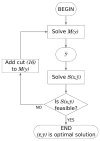Optimal Access Point Power Management for Green IEEE 802.11 Networks
- PMID: 33809509
- PMCID: PMC7998767
- DOI: 10.3390/s21062076
Optimal Access Point Power Management for Green IEEE 802.11 Networks
Abstract
In this paper, we present an approach and an algorithm aimed at minimising the energy consumption of enterprise Wireless Local Area Networks (WLANs) during periods of low user activity. We act on two network management aspects: powering off some Access Points (APs), and choosing the level of transmission power of each AP. An efficient technique to allocate the user terminals to the various APs is the key to achieving this goal. The approach has been formulated as an integer programming problem with nonlinear constraints, which comes from a general but accurate characterisation of the WLAN. This general problem formulation has two implications: the formulation is widely applicable, but the nonlinearity makes it NP-hard. To solve this problem to optimality, we devised an exact algorithm based on a customised version of Benders' decomposition method. The computational results proved the ability to obtain remarkable power savings. In addition, the good performance of our algorithm in terms of solving times paves the way for its future deployment in real WLANs.
Keywords: energy efficiency; green networking; mixed integer non-linear programming; network management; optimisation; resource allocation; wireless LAN.
Conflict of interest statement
The authors declare no conflict of interest.
Figures





References
-
- Wang X., Vasilakos A.V., Chen M., Liu Y., Kwon T.T. A Survey of Green Mobile Networks: Opportunities and Challenges. Mob. Netw. Appl. 2012;17:4–20. doi: 10.1007/s11036-011-0316-4. - DOI
-
- Wildemeersch M., Quek T., Slump C., Rabbachin A. Cognitive Small Cell Networks: Energy Efficiency and Trade-Offs. IEEE Trans. Commun. 2013;61:4016–4029. doi: 10.1109/TCOMM.2013.072213.120588. - DOI
-
- Pantazis N., Nikolidakis S., Vergados D. Energy-Efficient Routing Protocols in Wireless Sensor Networks: A Survey. IEEE Commun. Surv. Tutorials. 2013;15:551–591. doi: 10.1109/SURV.2012.062612.00084. - DOI
-
- Mehmood A., Khan S., Shams B., Lloret J. Energy-efficient multi-level and distance-aware clustering mechanism for WSNs. Int. J. Commun. Syst. 2015;28:972–989. doi: 10.1002/dac.2720. - DOI
-
- De La Oliva A., Banchs A., Serrano P. Throughput and energy-aware routing for 802.11 based mesh networks. Comput. Commun. 2012;35:1433–1446. doi: 10.1016/j.comcom.2012.04.004. - DOI
LinkOut - more resources
Full Text Sources
Other Literature Sources
Miscellaneous

